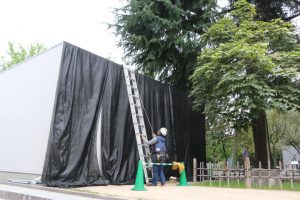Chinese parasol tree that survived atomic bombing wilts; possibly because of heat reflected from G7 Summit Commemorative Gallery. Sun-shade nets put up by city government
Jul. 25, 2024
by Keiichi Nobira, Staff Writer
A Chinese parasol tree that survived the atomic bombing is weakening. The tree stands near the G7 Hiroshima Summit Commemorative Gallery in Hiroshima Peace Memorial Park, and the sunlight reflected from the structure may be a reason. On July 24, the city of Hiroshima put up sunshade nets on an exterior wall and the roof of the facility in an effort to restore the tree to health.
According to the city, an arborist reported earlier this month that the leaves of the seven-meter-tall Chinese parasol tree had become lighter in color and smaller in size. The tree stands about two meters east of the gallery, which was completed in May. The sunlight reflected from the prefabricated structure’s wall may be affecting the growth of the tree. It has been reported that there is nothing wrong with the other tree that stands further east.
As a countermeasure, the city covered the roof and the wall facing the tree with black polyethylene nets, spending 140,000 yen. Fertilizer will be applied soon. The city says it will “monitor the changes so that the condition will improve as much as possible.”
The Chinese parasol tree was exposed to the atomic bombing at the Hiroshima Telecommunications Bureau (now part of Higashihakushima-cho, Naka Ward), 1.3 kilometers from the hypocenter. It was once said that no trees or plans would grow in Hiroshima for 70 years, but the tree produced new leaves the next year, giving hope to people. In 1973, it was transplanted to the north side of the east building of the Hiroshima Peace Memorial Museum.
The gallery is an exhibition facility for displaying materials related to the summit meeting of the Group of Seven (G7) industrialized nations held in Hiroshima in May last year. In response to the weakening of the tree, a Hiroshima citizen group asked the city government to remove the gallery. The group was formed with a view to consider the meaning of the Hiroshima Summit and is composed of 10 organizations, including the Hiroshima Prefectural Confederation of A-bomb Sufferers Organizations, chaired by Kunihiko Sakuma, and the Hiroshima Council against Atomic and Hydrogen Bombs. Mr. Sakuma said, “It is too sad that the tree is dying not because of its age, but because of external factors.”
(Originally published on July 25, 2024)
A Chinese parasol tree that survived the atomic bombing is weakening. The tree stands near the G7 Hiroshima Summit Commemorative Gallery in Hiroshima Peace Memorial Park, and the sunlight reflected from the structure may be a reason. On July 24, the city of Hiroshima put up sunshade nets on an exterior wall and the roof of the facility in an effort to restore the tree to health.
According to the city, an arborist reported earlier this month that the leaves of the seven-meter-tall Chinese parasol tree had become lighter in color and smaller in size. The tree stands about two meters east of the gallery, which was completed in May. The sunlight reflected from the prefabricated structure’s wall may be affecting the growth of the tree. It has been reported that there is nothing wrong with the other tree that stands further east.
As a countermeasure, the city covered the roof and the wall facing the tree with black polyethylene nets, spending 140,000 yen. Fertilizer will be applied soon. The city says it will “monitor the changes so that the condition will improve as much as possible.”
The Chinese parasol tree was exposed to the atomic bombing at the Hiroshima Telecommunications Bureau (now part of Higashihakushima-cho, Naka Ward), 1.3 kilometers from the hypocenter. It was once said that no trees or plans would grow in Hiroshima for 70 years, but the tree produced new leaves the next year, giving hope to people. In 1973, it was transplanted to the north side of the east building of the Hiroshima Peace Memorial Museum.
The gallery is an exhibition facility for displaying materials related to the summit meeting of the Group of Seven (G7) industrialized nations held in Hiroshima in May last year. In response to the weakening of the tree, a Hiroshima citizen group asked the city government to remove the gallery. The group was formed with a view to consider the meaning of the Hiroshima Summit and is composed of 10 organizations, including the Hiroshima Prefectural Confederation of A-bomb Sufferers Organizations, chaired by Kunihiko Sakuma, and the Hiroshima Council against Atomic and Hydrogen Bombs. Mr. Sakuma said, “It is too sad that the tree is dying not because of its age, but because of external factors.”
(Originally published on July 25, 2024)








